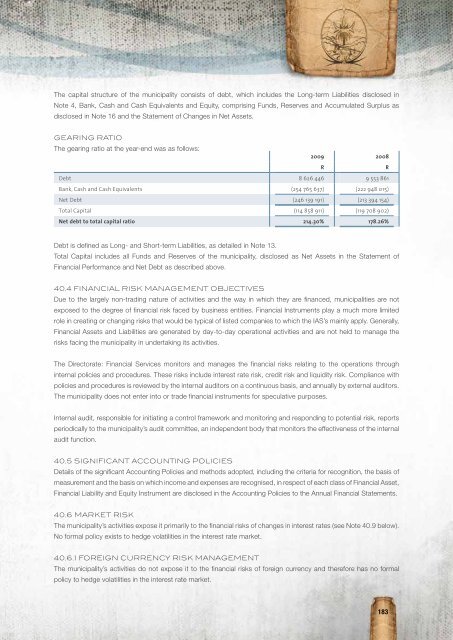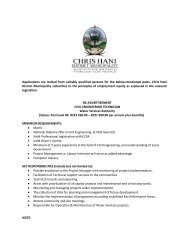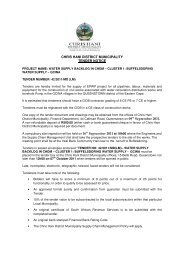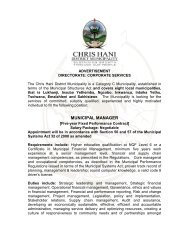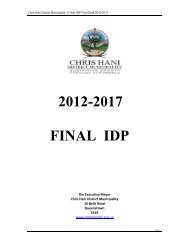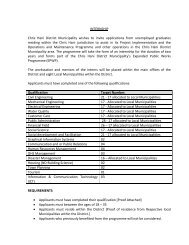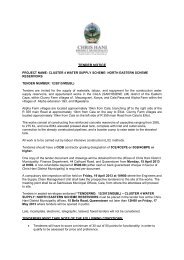Entire Document - Chris Hani District Municipality
Entire Document - Chris Hani District Municipality
Entire Document - Chris Hani District Municipality
Create successful ePaper yourself
Turn your PDF publications into a flip-book with our unique Google optimized e-Paper software.
The capital structure of the municipality consists of debt, which includes the Long-term Liabilities disclosed in<br />
Note 4, Bank, Cash and Cash Equivalents and Equity, comprising Funds, Reserves and Accumulated Surplus as<br />
disclosed in Note 16 and the Statement of Changes in Net Assets.<br />
Gearing Ratio<br />
The gearing ratio at the year-end was as follows:<br />
2009 2008<br />
R<br />
R<br />
Debt 8 626 446 9 553 861<br />
Bank, Cash and Cash Equivalents (254 765 637) (222 948 015)<br />
Net Debt (246 139 191) (213 394 154)<br />
Total Capital (114 858 911) (119 708 902)<br />
Net debt to total capital ratio 214.30% 178.26%<br />
Debt is defined as Long- and Short-term Liabilities, as detailed in Note 13.<br />
Total Capital includes all Funds and Reserves of the municipality, disclosed as Net Assets in the Statement of<br />
Financial Performance and Net Debt as described above.<br />
40.4 Financial Risk Management Objectives<br />
Due to the largely non-trading nature of activities and the way in which they are financed, municipalities are not<br />
exposed to the degree of financial risk faced by business entities. Financial Instruments play a much more limited<br />
role in creating or changing risks that would be typical of listed companies to which the IAS’s mainly apply. Generally,<br />
Financial Assets and Liabilities are generated by day-to-day operational activities and are not held to manage the<br />
risks facing the municipality in undertaking its activities.<br />
The Directorate: Financial Services monitors and manages the financial risks relating to the operations through<br />
internal policies and procedures. These risks include interest rate risk, credit risk and liquidity risk. Compliance with<br />
policies and procedures is reviewed by the internal auditors on a continuous basis, and annually by external auditors.<br />
The municipality does not enter into or trade financial instruments for speculative purposes.<br />
Internal audit, responsible for initiating a control framework and monitoring and responding to potential risk, reports<br />
periodically to the municipality’s audit committee, an independent body that monitors the effectiveness of the internal<br />
audit function.<br />
40.5 Significant Accounting Policies<br />
Details of the significant Accounting Policies and methods adopted, including the criteria for recognition, the basis of<br />
measurement and the basis on which income and expenses are recognised, in respect of each class of Financial Asset,<br />
Financial Liability and Equity Instrument are disclosed in the Accounting Policies to the Annual Financial Statements.<br />
40.6 Market Risk<br />
The municipality’s activities expose it primarily to the financial risks of changes in interest rates (see Note 40.9 below).<br />
No formal policy exists to hedge volatilities in the interest rate market.<br />
40.6.1 Foreign Currency Risk Management<br />
The municipality’s activities do not expose it to the financial risks of foreign currency and therefore has no formal<br />
policy to hedge volatilities in the interest rate market.<br />
183


